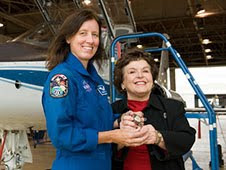
America 's plans for opening the space frontier, including new human exploration of Earth's moon and future voyages into the solar system, are featured in an interactive exhibit scheduled to visit Twin Falls Sept. 30 – Oct. 3, 2009 .
"We hope the multimedia experience helps people better understand how the country plans to explore the moon and travel beyond in the next decade or so," said outreach coordinator Sarah (Keyke) Reed from NASA's Marshall Space Flight Center in Huntsville , Ala.
Hosted by the Herrett Center for Arts and Science Museum , the Exploration Experience Exhibit will be featured at the Arts and Science Museum on the main campus of the College of Southern Idaho Sept. 30 – Oct. 3, 2009 . It will be open to the public Sept. 30 from 9 a.m. to 4:30 p.m. MDT ; Oct. 1 and 3 from 10 a.m. to 4:30 p.m. MDT ; and Oct. 2 from 10 a.m. to 3 p.m. and 5 p.m. to 9 p.m. MDT .
"Interactive control panels and activity station, immersive 3D imagery and audio effects will transport visitors into a not-too-distant future on the moon," Reed added. "They'll discover what it will be like to live and work on the surfaces of other worlds – and how it will benefit life back home on Earth."
The tour will continue at Kenneth J. Carberry Intermediate School , a NASA Explorer School , in Emmett from Oct. 12-14, 2009 .
NASA staffers will be available at each tour stop to answer questions and discuss some of the thousands of technologies used on Earth as a result of years of space-based research and development by the agency and its partners.
"Exhibit visitors can learn how our quality of life improves when America's space exploration activities refine existing technologies and develop new breakthroughs in areas such as power generation, computer technology, communications, networking and robotics," said Reed. Visitors also can learn how other advanced technologies are increasing the safety and reliability of space transportation systems, while also reducing costs.
Touring the NASA Exploration Experience exhibit takes approximately 10 minutes. The exhibit is free and wheelchair-accessible. Exhibit visitors also can see what they would look like on the moon by having their photo taken in a space suit in front of a lunar landscape.
NASA's Aerospace Education Services Project, a NASA resource that delivers education programs in all 50 states and U.S. territories, will support the exhibit. The Marshall Space Flight Center manages the traveling exhibit for the agency's Exploration Systems Mission Directorate in Washington , D.C. In addition to the traveling exhibit, "Robots on the Road," a hands-on robotics experience, will be on site Sept. 30 to Oct. 3, 2009 .
 Along with the obvious thrill of launching into space, astronaut Shannon Walker's flight to the space station next year will hold a sentimental and historical significance. Flying alongside Walker will be the watch of Amelia Earhart, the legendary aviator who was the first woman to fly as a passenger across the Atlantic Ocean . Earhart later became the first woman to pilot a plane across that same ocean in a solo flight.
Along with the obvious thrill of launching into space, astronaut Shannon Walker's flight to the space station next year will hold a sentimental and historical significance. Flying alongside Walker will be the watch of Amelia Earhart, the legendary aviator who was the first woman to fly as a passenger across the Atlantic Ocean . Earhart later became the first woman to pilot a plane across that same ocean in a solo flight.
















